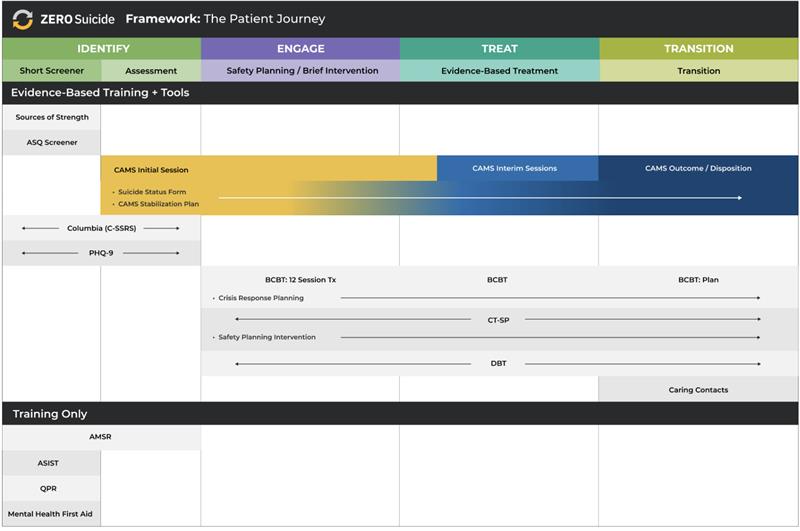
Youth mental health remains a growing concern in the U.S. According to the Centers for Disease Control and Prevention (CDC), suicide is the second-leading cause of death for teens and young adults between the ages of 10–34 in the U.S. [1] Additionally, 36.7% of young adults ages 18–25 have mental health needs that are not being treated. [2]
It is common for family members, especially caregivers, to feel overwhelmed. They may wonder what to do when a loved one talks about suicide. CAMS (Collaborative Assessment and Management of Suicidality) is an evidence-based treatment for suicide that allows family members to be a part of the process. It puts emphasis on the “collaborative” aspect. Rather than teaching and handing off the tools to the at-risk person to manage themselves, CAMS strives to involve parents and caregivers. The Stabilization Support Plan is one way that CAMS does this. This plan provides guidance to family members to help support their child’s treatment moving forward. This helps create a bigger system of support for the person who is struggling.
The Role that Family Plays
Family members and caregivers play crucial roles in helping support their child’s mental health. Adolescence is often a time of instability and change—from changes in friendships to increased demands at school and other activities. Children and teens who are close with their family members have positive, built-in relationships with people they can rely on for help and support through the ups and downs. Here are a few specific ways that family members can help each other when it comes to mental health and suicide prevention.
Offering emotional support
In a healthy dynamic, family members can provide emotional support to one another. They provide safe spaces for each other to open up and share about their struggles. Families often have deep bonds from shared experiences, good and bad. They know each other’s history, struggles, and triumphs. They are often the first place that people go to with those struggles and triumphs. Having people available to lean on during these times can be extremely helpful.
Detecting early warning signs of suicide
Family members may be more in-tune and aware of certain warning signs, sensing when things seem “off.” They can easily detect abnormal behavior since they’re familiar with what normal behavior looks like. They are often able to be on alert for signs of distress. Being able to identify warning signs and abnormal behaviors in someone is a key first step to suicide prevention.
Being involved with treatment
When it comes to treatment, family members and caregivers are able to be more easily and seamlessly involved than those on the outside. Parents and caregivers can help their child stay healthy. They can manage logistics like scheduling and driving to appointments. They can also encourage their child to follow treatment plans.
Family: A Protective Factor
When talking about suicide, risk factors and protective factors are important to discuss. Risk factors are things that make suicide more likely. Protective factors are things that make suicide less likely. Some people are naturally more at risk than others depending on their background and living situation. According to the Suicide Prevention Resource Center, social isolation can be a big risk factor. Connectedness to other individuals, community, and family is a protective factor. [3] Therefore, it’s important for families to be present and know how to help their child or adolescent through their struggles.
Ways CAMS Supports Family Involvement
Unlike many other types of treatment methods, CAMS puts a large emphasis on collaboration when it comes to working with and supporting the at-risk individual. CAMS is set up to help family members be involved and take an active role in their loved one’s treatment, especially when dealing with parents and children. One way is through CAMS-4Teens®. CAMS-4Teens is a specific method of using the CAMS Framework® to treat children, teens, and young adults who are struggling with thoughts of suicide. Parents and caregivers are engaged in this process, as well. They are given expectations and information up front about the treatment. They are updated regularly as the treatment goes on. They join sessions to learn about their child’s “suicidal drivers.” They also discuss stabilization and support plans, among other topics.
Allowing parents to have a more active role in their child’s treatment allows for open communication and helps reduce the stigma about mental health and suicide. Parents and caregivers can learn about what leads to thoughts of suicide. They can also understand the CAMS therapy approach. This knowledge helps them better understand their child’s mind.
Benefits of CAMS for Families
CAMS not only benefits the person at risk, but it can help families as a whole grow closer and move forward together in confidence. Here are a few of the specific areas in which families can benefit when working with CAMS.
Insight into the issues
Many young people, especially teenagers, struggle with issues related to friendships, insecurity, and comparing themselves to their peers. In CAMS, the patient is always listened to first. This helps the therapist see the person’s suicidal thoughts from their point of view. This makes it easier to share these thoughts with family members who can then gain a better understanding.
Greater sense of control and direction
CAMS allows parents and caregivers the opportunity to get a glimpse into what is going on
and what their role is in helping their child. This is helpful for the children but also helpful for the parents. It gives them a greater understanding and knowledge about what tools and techniques their child is learning to deal with their difficult thoughts and feelings.
Strengthening trust and relationships
When mental health is openly talked about, trust is more easily built. Family members of any age can benefit from these open conversations around mental health and struggles. When parents and caregivers see how serious the issue is, it helps their child. They also learn what is being done to help. This way, the child can trust that their parents care about what is happening.
Increased confidence in dealing with a crisis
A common fear that many parents and caregivers have is that they will make a situation worse by saying or doing the wrong thing, particularly in a moment of crisis. CAMS works with parents to put a plan in place for dealing with emergencies. That way, if a crisis happens, parents and caregivers will know how to respond appropriately.
Warning Signs to Watch For
It’s always important to stay aware of the warning signs of suicide, especially because they may look different for people of different ages. Here are some warning signs to watch for from the Substance Abuse and Mental Health Services Administration (SAMHSA): [4]
Warning signs in adults:
- Talking about or making a plan for suicide
- Behaving recklessly or acting agitated
- Talking about feeling trapped or like a burden
- Increased use of alcohol or drugs
- Withdrawing or isolating from others
- Changes in sleep (increased or decreased)
- Showing signs of rage
- Displaying extreme mood swings
Warning signs in youth and children:
- Expressing hopelessness about the future
- Displaying severe or overwhelming emotional distress
- Withdrawing or isolating from others
- Changes in sleep (increased or decreased)
- Sudden anger or hostility that seems out of character
- Increased irritability
Supporting a loved one who is struggling with suicidal ideation can feel overwhelming and even scary, especially those who feel ill equipped. CAMS aims to help families by offering them a lifeline and including them on the healing journey. CAMS helps parents and caregivers by encouraging open talks about struggles. It focuses on what matters most to the person at risk. This way, they gain the tools and confidence to support their loved one on the path to recovery.
Curious to learn more about CAMS-4Teens? See more information in this article here: Proven CAMS-4Teens Strategies to Treat Adolescent Suicide. For those interested in or pursuing CAMS-Trained™ designation, check out our on-demand video CAMS-4Teens: Working with Parents. This 3-hour video training covers how therapists can work with parents to support the use of CAMS treatment with their child using the Stabilization Support Plan.
For more help and tips on supporting a loved one, see this guide from the Center for Suicide Research and Prevention with resources.
Remember, if you or someone you know is in crisis, reach out to the 988 Suicide & Crisis Lifeline via call, text, or online chat.
Sources:
[1] https://www.cdc.gov/nchs/data/vsrr/vsrr024.pdf
[2] https://www.samhsa.gov/data/sites/default/files/reports/rpt47095/National%20Report/National%20Report/2023-nsduh-annual-national.pdf
[3] https://sprc.org/risk-and-protective-factors/
[4] https://www.samhsa.gov/mental-health/suicidal-behavior/warning-signs



